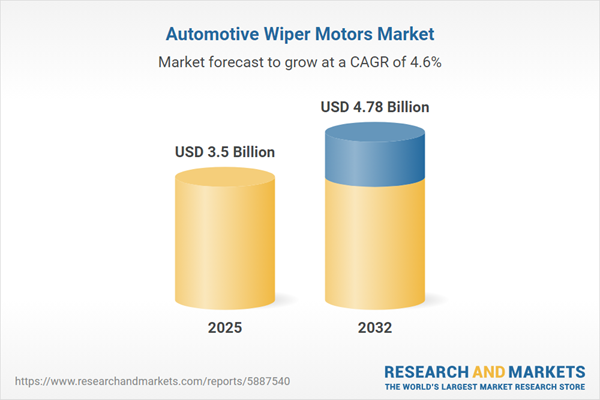Speak directly to the analyst to clarify any post sales queries you may have.
The automotive wiper motors market is experiencing steady transformation as new technologies and shifting supply chain realities shape the industry. Senior decision-makers face evolving requirements for efficiency, integration, and regional adaptability in both OEM and aftermarket segments.
Market Snapshot: Automotive Wiper Motors Market
The worldwide automotive wiper motors market grew from USD 3.35 billion in 2024 to USD 3.50 billion in 2025. With a projected CAGR of 4.55%, revenues are expected to reach USD 4.78 billion by 2032. Growth is supported by sustained investment in advanced motor architectures and adaptive control systems aligned with enhanced safety and regulatory demands.
Scope & Segmentation of the Automotive Wiper Motors Market
This report delivers expansive analysis across products, channels, vehicle categories, motor types, system configurations, and international regions:
- Product Types: Front Wiper Motor, Integrated Wiper Motor, Rear Wiper Motor
- Distribution Channels: Aftermarket (including E-Commerce, Retailer, Wholesaler), Original Equipment Manufacturers
- Vehicle Types: Commercial Vehicle, Passenger Vehicle
- Motor Types: Brushed DC, Brushless DC (Sensored, Sensorless)
- System Types: Beam, Conventional, Hybrid
- Geographic Regions: Americas (United States, Canada, Mexico, Brazil, Argentina, Chile, Colombia, Peru), Europe Middle East & Africa (United Kingdom, Germany, France, Russia, Italy, Spain, Netherlands, Sweden, Poland, Switzerland, United Arab Emirates, Saudi Arabia, Qatar, Turkey, Israel, South Africa, Nigeria, Egypt, Kenya), Asia-Pacific (China, India, Japan, Australia, South Korea, Indonesia, Thailand, Malaysia, Singapore, Taiwan)
- Representative Companies: Valeo SA, Robert Bosch GmbH, Denso Corporation, Mitsuba Corporation, Nihon SunRho Co., Ltd., Nidec Corporation, Johnson Electric Holdings Limited, Trico Products Inc., Tenneco Inc., Marelli Holdings Co., Ltd.
Key Takeaways for Automotive Wiper Motors Decision-Makers
- Increasing integration of sensor-based and adaptive motor control technologies is enabling dynamic operation and improved safety features within vehicle platforms.
- The shift to brushless DC architectures directly addresses longer service life and lower maintenance, especially amid commercial fleet adoption and premium passenger vehicle requirements.
- Cross-disciplinary innovation is apparent, where mechanical engineering, advanced electronics, and embedded software combine to deliver seamless integration with wider vehicle control and driver assistance systems.
- Aftermarket channels are embracing digitalization and e-commerce for timely replacement solutions, while OEM relationships focus on bespoke performance and large-scale contract manufacturing.
- Regional demand drivers vary significantly, with North American and European markets adding requirements for energy efficiency and regulatory compliance, and Asia-Pacific exhibiting an expanding base on the strength of vehicle production and ownership growth.
United States Tariff Impact on Wiper Motor Supply Chains
Planned tariff changes are substantially influencing how supplier networks are structured. Manufacturers are increasingly exploring local production partnerships and dual sourcing strategies to minimize exposure to import duties and logistics risks. Enhanced local assembly, nearshoring, and vertical integration help anchor business continuity in response to new fiscal pressures. Suppliers’ efforts to innovate in electronic control modules also support value retention in regional markets while streamlining distribution and inventory management for both OEM and aftermarket needs.
Primary Keyword: Automotive Wiper Motors Market
Methodology & Data Sources
This report utilizes in-depth interviews with OEM executives, tier-one suppliers, and distributors, supported by secondary research in technical journals, industry reports, and trade data. Consistency and accuracy are ensured through triangulation and validation workshops with industry stakeholders throughout the analytic process.
Why This Report Matters
- Supports data-driven strategic planning with granular segmentation and regional dynamics impact analysis.
- Enables leadership teams to navigate tariffs, technology changes, and aftermarket growth with validated, actionable market intelligence.
- Provides forward-looking insights into supplier positioning, innovation ecosystems, and distribution channel evolution.
Conclusion
The automotive wiper motors market is progressing through a phase of intelligent component integration and shifting geographic strategies. Companies that invest in supply chain resilience, digitalization, and adaptive product development are better positioned to lead in an environment defined by regulatory shifts and technological evolution.
Additional Product Information:
- Purchase of this report includes 1 year online access with quarterly updates.
- This report can be updated on request. Please contact our Customer Experience team using the Ask a Question widget on our website.
Table of Contents
3. Executive Summary
4. Market Overview
7. Cumulative Impact of Artificial Intelligence 2025
Companies Mentioned
The companies profiled in this Automotive Wiper Motors market report include:- Valeo SA
- Robert Bosch GmbH
- Denso Corporation
- Mitsuba Corporation
- Nihon SunRho Co., Ltd.
- Nidec Corporation
- Johnson Electric Holdings Limited
- Trico Products, Inc.
- Tenneco Inc.
- Marelli Holdings Co., Ltd.
Table Information
| Report Attribute | Details |
|---|---|
| No. of Pages | 191 |
| Published | October 2025 |
| Forecast Period | 2025 - 2032 |
| Estimated Market Value ( USD | $ 3.5 Billion |
| Forecasted Market Value ( USD | $ 4.78 Billion |
| Compound Annual Growth Rate | 4.5% |
| Regions Covered | Global |
| No. of Companies Mentioned | 11 |









